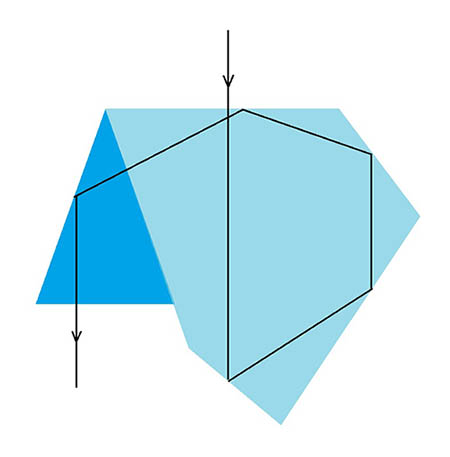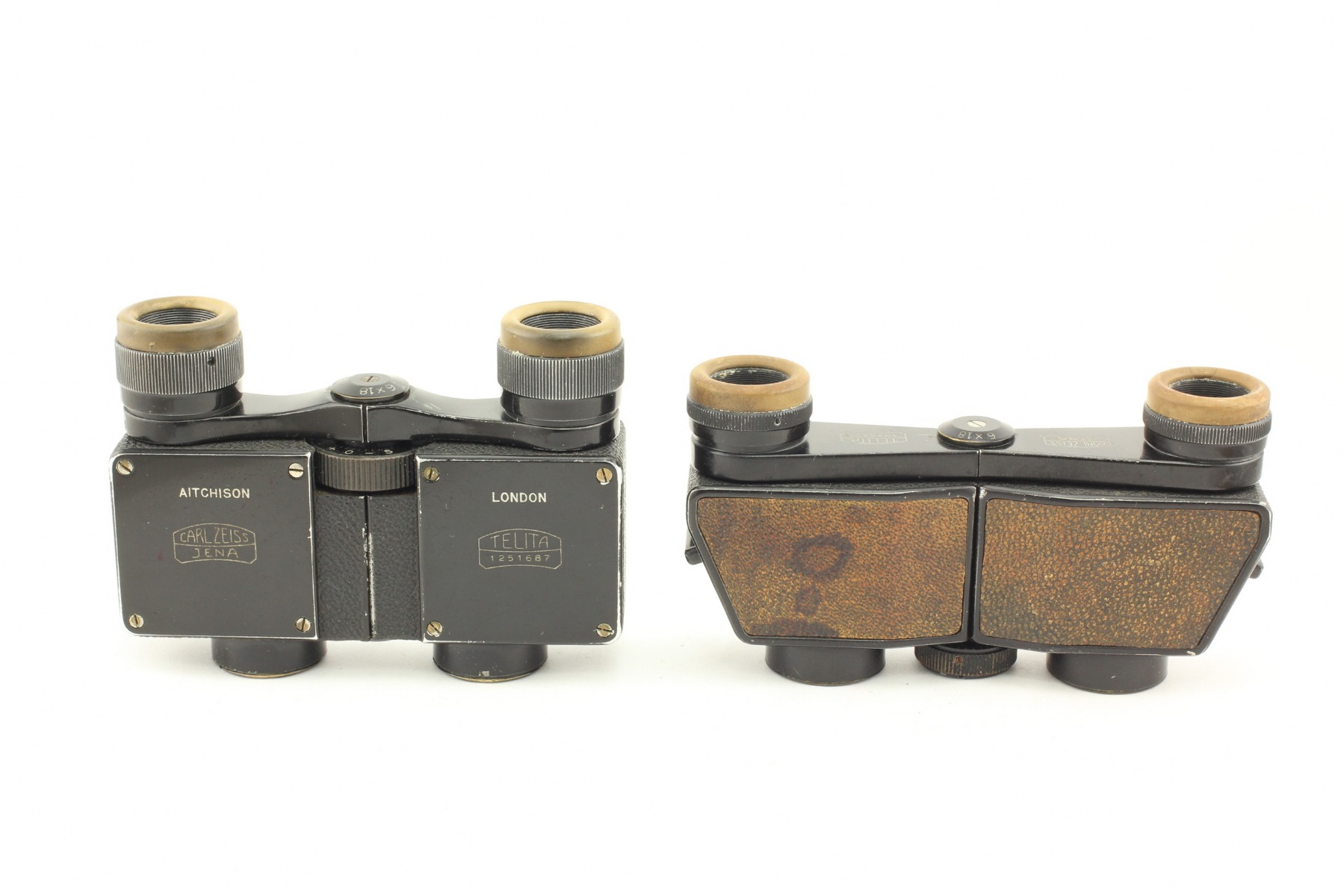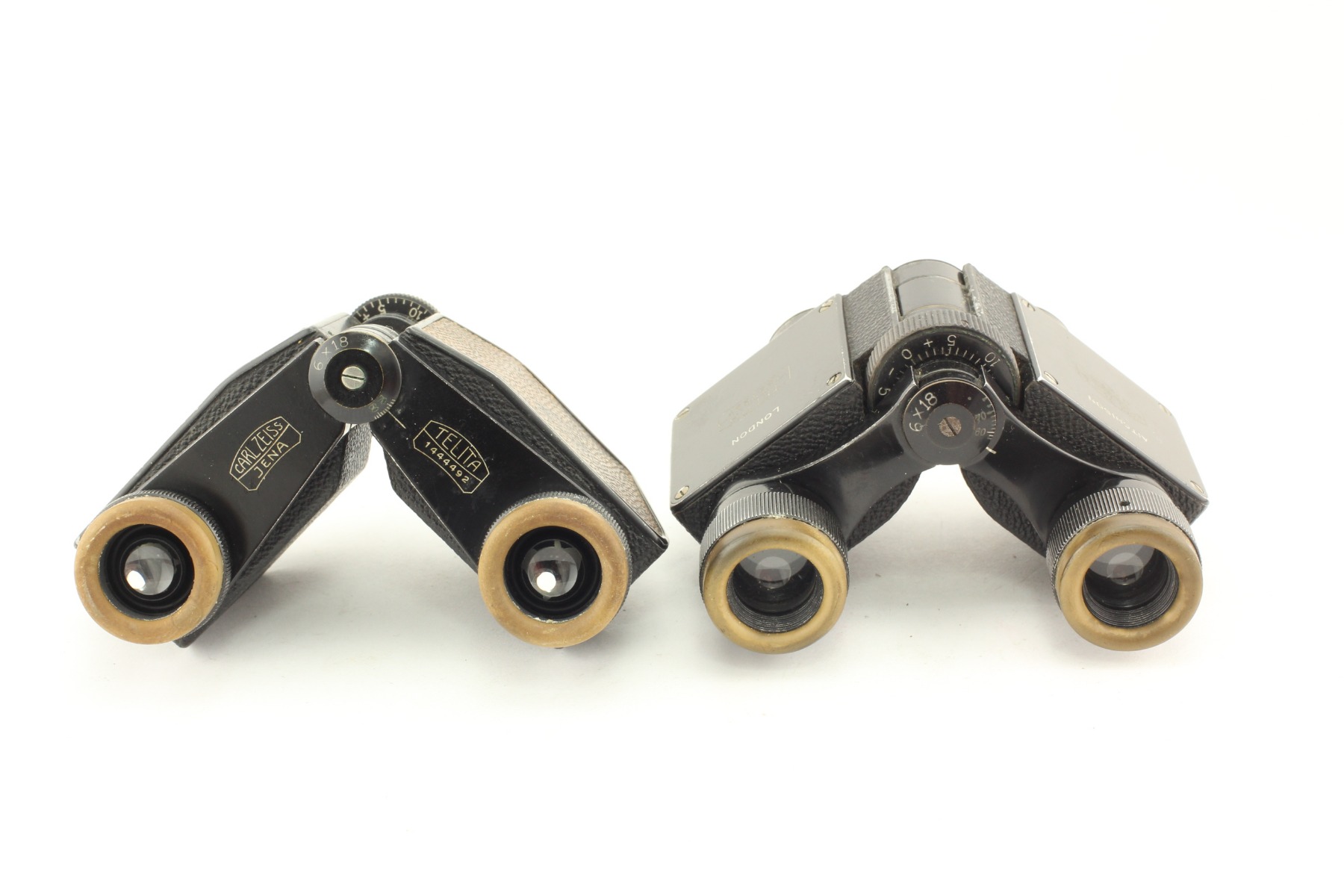Magnification: 6x
Aperture (objective diameter): 18 mm
Field of view: 8.3°
Outlet pupil diameter: 3 mm
The closest focusing distance: 1.6 m
Width: 11.8 cm
Height: 6.5 cm
Weight: 165 g
Production date: 1928.
Binoculars Carl Zeiss Jena Telita II 6x18
In 1920, the German optical firm J.D. Möller Optische Werke GmbH, founded in 1864, patents a new optical prism. It is a gluing of two parts (see picture). Due to only two air-to-glass transitions, binoculars with such prisms had better contrast and higher light transmission (and therefore a brighter image) than binoculars with Porro prisms (four air-to-glass transitions).

J.D. Möller Optische Werke GmbH began to produce binoculars with new prisms, and based its advertising on the above fact: why buy more bulky and heavy binoculars on Porro prisms, if you can buy our compact and lightweight binoculars with the same high-quality image?
The management of Carl Zeiss Jena did not like this much: the vast majority of Carl Zeiss binoculars had Porro prisms. A lawsuit began between the two firms, which ended in victory ... J.D. Möller Optische Werke GmbH. This is one of the few cases where Carl Zeiss has lost a lawsuit.
Carl Zeiss engineers did not remain in debt, and in 1923, the "flat" compact Telita 6x18 binoculars appeared, structurally very similar to Möller's binoculars. But Carl Zeiss respected patent law and used the old scheme of prisms from the French company Huet as a turning system.
Telita 6x18 of the first generation (Telita I) had a central focus and flawless mechanical part. However, the optics turned out to be unsuccessful: unlike the competitor, the exit pupil was not round, but “cropped”. In this form, with minor changes (hull finishing materials), this device was produced until 1926. A total of 3,500 copies of this rather rare binocular were produced.
In 1926, the second generation of binoculars - Telita II - was released. It had the same optical characteristics, but it used different, slightly modified Möller prisms. The optical characteristics have improved significantly (it was possible to eliminate the “cropping” of the exit pupil), and the device was produced in this form until 1943.
The binoculars, which are presented today in our virtual museum, belong to the second modification of this model. It has a central hinge, on the upper washer of which a scale of interpupillary distances is applied, the magnification and aperture (lens diameter) of the binoculars are 6x18.
The design of the case is very different from the first modification: the binoculars have become lower, but wider (see photo below, second modification on the right). In the working position, both devices strongly “fold” (see photo).


The eyepiece housings have a longitudinal knurling, the diameter of the base of the eyepieces is 18 mm. The height of the prism bodies is 34 mm, the width is 58 mm, and the thickness is 27 mm. The focusing of the device is central, the focusing wheel has a rare location - in front (near the lenses) of the binoculars. Focusing with this design is most convenient to do ... little fingers). Lens diameter - 18 mm. The accuracy of manufacturing parts of the binoculars surprises: with such long arms of the central focusing bridge, not the slightest jamming occurs. The flywheel of the central focus rotates easily and freely.
The inscriptions on the left shoulder of the central focus are "Carl Zeiss". On the right - "Telita 1444492". The inscription is printed in block letters against the background of a schematic image of a Carl Zeiss Tessar photographic lens.
The case for binoculars is rich in various inscriptions (see photo). There is an embossing “DUNNELL” on the top: most likely, this is the name of one of the owners of these binoculars. Below - "Dixey. Optician to the king. 19 Old Bond st. London”: the binoculars were sold in the oldest English chain of optics stores by C.W. Dixey & Son. The company was founded in 1777 and was engaged in the production and sale of various optical instruments, including glasses. There is another inscription even lower, but it is difficult to see.
The serial number of the binoculars is 1444492, it was made in 1928. According to the book Hans T.Seeger. Zeiss-Feldstecher, Handfernglaser von 1919-1946, Modelle-Merkmale-Mythos, p. 860, it falls into a batch of Telex 6x24 binoculars (serial numbers from 1444401 to 1445000), but the previous batch (numbers 1443901-1444400) is just marked as Telita 6x18. This situation with serial numbers occurs quite often, since there is no exact information on serial numbers and models of that time and requires constant adjustment.
The first version of the Carl Zeiss Telita 6x18 model https://binocollection.com/catalog/binoculars-carl-zeiss-jena-telita-i-6x18.html
The management of Carl Zeiss Jena did not like this much: the vast majority of Carl Zeiss binoculars had Porro prisms. A lawsuit began between the two firms, which ended in victory ... J.D. Möller Optische Werke GmbH. This is one of the few cases where Carl Zeiss has lost a lawsuit.
Carl Zeiss engineers did not remain in debt, and in 1923, the "flat" compact Telita 6x18 binoculars appeared, structurally very similar to Möller's binoculars. But Carl Zeiss respected patent law and used the old scheme of prisms from the French company Huet as a turning system.
Telita 6x18 of the first generation (Telita I) had a central focus and flawless mechanical part. However, the optics turned out to be unsuccessful: unlike the competitor, the exit pupil was not round, but “cropped”. In this form, with minor changes (hull finishing materials), this device was produced until 1926. A total of 3,500 copies of this rather rare binocular were produced.
In 1926, the second generation of binoculars - Telita II - was released. It had the same optical characteristics, but it used different, slightly modified Möller prisms. The optical characteristics have improved significantly (it was possible to eliminate the “cropping” of the exit pupil), and the device was produced in this form until 1943.
The binoculars, which are presented today in our virtual museum, belong to the second modification of this model. It has a central hinge, on the upper washer of which a scale of interpupillary distances is applied, the magnification and aperture (lens diameter) of the binoculars are 6x18.
The design of the case is very different from the first modification: the binoculars have become lower, but wider (see photo below, second modification on the right). In the working position, both devices strongly “fold” (see photo).
The eyepiece housings have a longitudinal knurling, the diameter of the base of the eyepieces is 18 mm. The height of the prism bodies is 34 mm, the width is 58 mm, and the thickness is 27 mm. The focusing of the device is central, the focusing wheel has a rare location - in front (near the lenses) of the binoculars. Focusing with this design is most convenient to do ... little fingers). Lens diameter - 18 mm. The accuracy of manufacturing parts of the binoculars surprises: with such long arms of the central focusing bridge, not the slightest jamming occurs. The flywheel of the central focus rotates easily and freely.
The inscriptions on the left shoulder of the central focus are "Carl Zeiss". On the right - "Telita 1444492". The inscription is printed in block letters against the background of a schematic image of a Carl Zeiss Tessar photographic lens.
The case for binoculars is rich in various inscriptions (see photo). There is an embossing “DUNNELL” on the top: most likely, this is the name of one of the owners of these binoculars. Below - "Dixey. Optician to the king. 19 Old Bond st. London”: the binoculars were sold in the oldest English chain of optics stores by C.W. Dixey & Son. The company was founded in 1777 and was engaged in the production and sale of various optical instruments, including glasses. There is another inscription even lower, but it is difficult to see.
The serial number of the binoculars is 1444492, it was made in 1928. According to the book Hans T.Seeger. Zeiss-Feldstecher, Handfernglaser von 1919-1946, Modelle-Merkmale-Mythos, p. 860, it falls into a batch of Telex 6x24 binoculars (serial numbers from 1444401 to 1445000), but the previous batch (numbers 1443901-1444400) is just marked as Telita 6x18. This situation with serial numbers occurs quite often, since there is no exact information on serial numbers and models of that time and requires constant adjustment.
The first version of the Carl Zeiss Telita 6x18 model https://binocollection.com/catalog/binoculars-carl-zeiss-jena-telita-i-6x18.html
